NDT Engineering Technician Apprenticeship

| NDT Technician Apprenticeship |
| Duration: 24 months. |
| Funding Cap: Up to £18,000. |
| Apprenticeship Level: This is a Level 3 apprenticeship. |
| Standard Reference: AA020. |
| Entry Requirements: Three GCSEs (or equivalent) at grade C or above (grade 4 or above in the new grading system), including English and maths and good aided or unaided eyesight. |
| Qualifications Gained*: NDT Level 2 certification in three methods in accordance with national and international standards. |
| Professional Recognition: BINDT is licensed by the Engineering Council for registration for Engineering Technician (EngTech). |
| *PCN, EN4179 and CSWIP qualifications are accepted by prospective employers. |
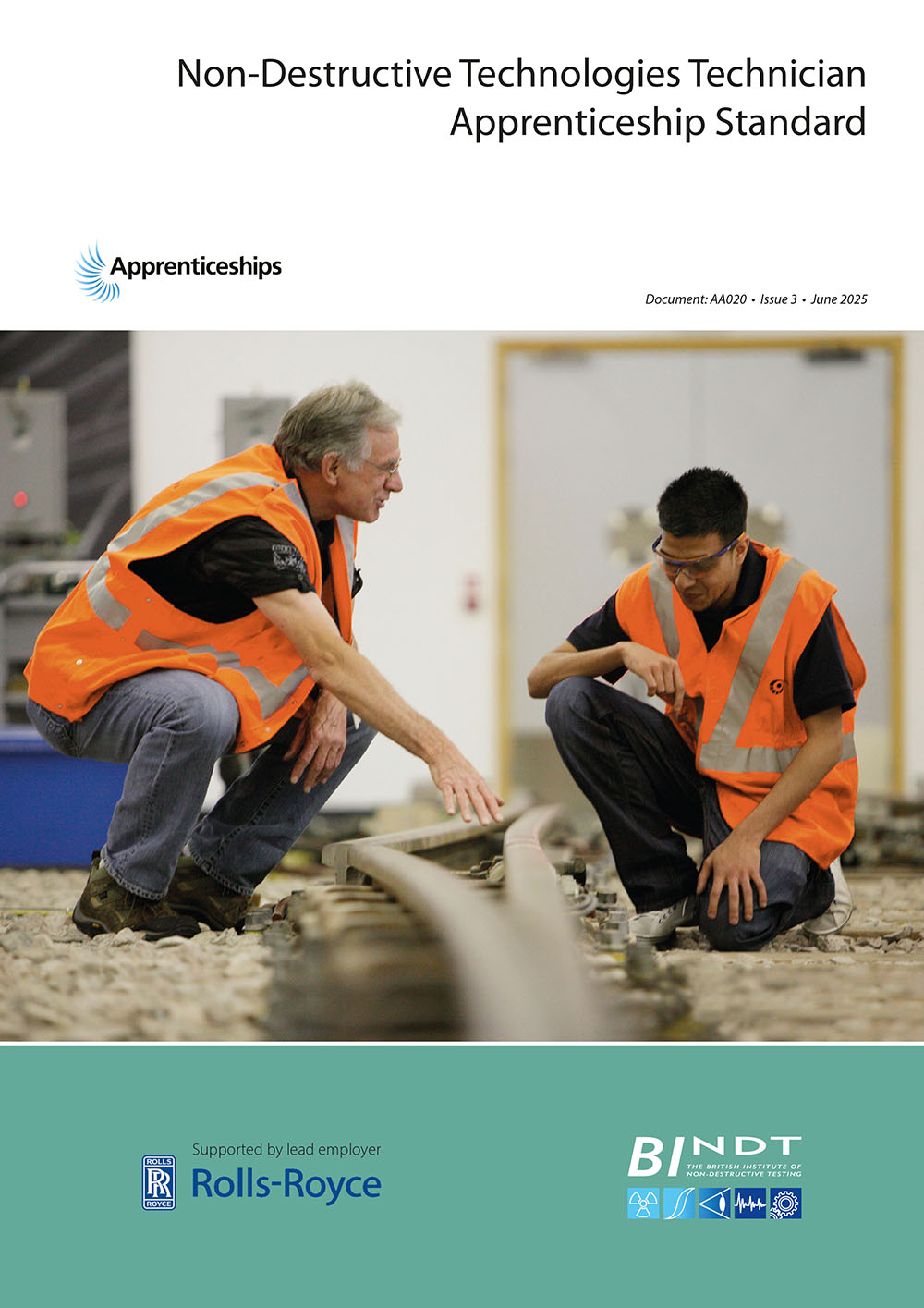 1. Occupational Profile
1. Occupational ProfileThis occupation is found across the engineering sector, including aerospace, motorsport, power generation and distribution, manufacturing, railways, automotive, oil & gas (on- and offshore), marine and construction. Employers vary in size, from small to large. Non-destructive technology (NDT) is an engineering science-based profession. It involves non-intrusive measurement, inspection or monitoring of assets, including plant, machines, materials, welds and components, to verify their integrity.
NDT contributes to sustainability and reduces environmental impact. NDT reports and data feedback can improve the design of an item, assuring that it is manufactured without unacceptable flaws. When in service, NDT assures that items are not fractured or degraded to unacceptable levels. It identifies optimum operating conditions and predicts remaining useful life of in-service plant and can lower manufacturing costs by reducing waste and using fewer materials. A component’s life in service can be safely extended by NDT, benefiting the environment.
Non-Destructive Technologies Technicians work at sites where NDT takes place. These include airports, construction sites, manufacturing facilities, civil engineering, water and gas distribution, refineries and nuclear power plants.
The broad purpose of the occupation is to ensure that the asset is fit for purpose. Non-Destructive Technologies Technicians organise and coordinate the NDT activity. They test equipment, establish the resources needed and assess the condition of the asset, collecting samples, conducting NDT tests and analysing the outputs. They complete documentation, write reports and also coach and support other team members.
In their daily work, an employee in this occupation interacts with other Technicians and NDT operatives. They also interact with external customers and auditors. They typically report to an NDT Engineer or Operations Director.
An employee in this occupation will be responsible for completing their duties in line with organisational procedures and standards. They must comply with health & safety, environmental, sustainability and engineering regulations and guidance, including specific NDT requirements. Where applicable, they may have to wear personal protective equipment and follow workplace safety rules, such as those for safely handling hazardous materials. They must work under limited direct supervision, ensuring the quality and accuracy of their own work and the work of others. They must ensure work is completed safely within agreed timescales and within budgets. They must work professionally and in an ethical manner.
2. Occupational Duties

- Plan and coordinate non-destructive technology work to meet stakeholders’ requirements
- Test equipment, identifying faults and taking action as needed
- Establish resources required to ensure customer and site compliance against defined acceptance criteria, for example accept all cracks to a certain length and in a particular position, then report other findings in a technical report
- Receive, read and interpret engineering data and documentation
- Evaluate and facilitate the stakeholders’ specific non-destructive technologies requirements via documented instructions; conduct any preparatory work, for example referring to relevant standards, specifications and regulations
- Assess the condition of the asset, component or material for compliance with stakeholders’ requirements and acceptance criteria; identify and fix issues with the asset, component or material, retesting as needed; report any defects and irregularities
- Collect NDT samples and record measurement points, monitoring intervals and operational state
- Conduct NDT testing and checks using testing, measuring or monitoring equipment on materials and components
- Interrogate the results and data obtained during the testing and monitoring of the items subjected to investigations
- Complete documentation for NDT tasks, for example test reports, risk assessments, equipment service records, adverse incident reports, technical investigations and equipment appraisals
- Complete written reports for NDT work, for example regulatory reports and technical investigations
- Inform stakeholders of work status and results, for example internal and external customers
- Conduct NDT technical performance reviews, for example asset checking and compliance checks, and internal or external quality audits
- Support and coach members of the NDT team.
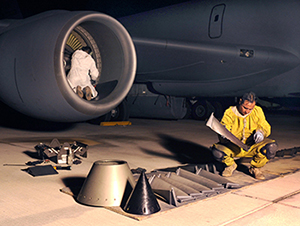 3. Knowledge, Skills and Behaviour gained through the Apprenticeship
3. Knowledge, Skills and Behaviour gained through the Apprenticeship3.1 Knowledge – Understanding of:
- The non-destructive technologies engineering function and role of the Non-Destructive Technologies Technician; limits of autonomy and reporting channels
- Planning, organising, workflow and time management techniques
- Principles of identifying, organising and using resources and how they impact cost, quality, safety, security and environment
- Principles of planning, preparing for and applying inspections, tests and monitoring on materials, products, plant or
machinery using
non-destructive technology - Contextual information: purpose and requirements prior to applying
non-destructive technology on specific products, plant or machinery relevant to the specific industry - Health & safety regulations, their relevance to the occupation and the Technician’s responsibilities. Health and Safety at Work Act – responsibilities; Control of Substances Hazardous to Health (COSHH); Reporting of Injuries, Diseases and Dangerous Occurrences Regulations (RIDDOR); manual handling; types of hazard; near-miss reporting; due diligence; personal protective equipment (PPE); situational awareness; slips, trips and falls; working in confined spaces; working at height; lone working; electrical safety and compliance; noise regulation; legionella; display screen equipment; ionising and non-ionising radiation (IRR19); and electromagnetic radiation
- Risk assessments and safe systems of working
- Environment and sustainability regulations and guidance relevance to the occupation and the Technician’s responsibilities; Environmental Protection Act; types of pollution and control measures; noise, smells, spills and waste; sustainability; efficient use of resources; environmental permits; waste management; Waste Electrical and Electronic Equipment (WEEE) Directive; recyclable materials and waste disposal procedures; and net-zero commitment
- Project management techniques and phases: project planning and execution to completion, costs, budgets, resources, quality, safety, security and the environment
- Quality assurance: awareness of quality management standards policy, principles and practices, relevance to the occupation and the Technician’s responsibilities
- Mathematical techniques and scientific and engineering principles: calculations using formulae, ratios, SI units and trigonometry
- International and national standards for engineering representations, drawings, graphical information and
datasets
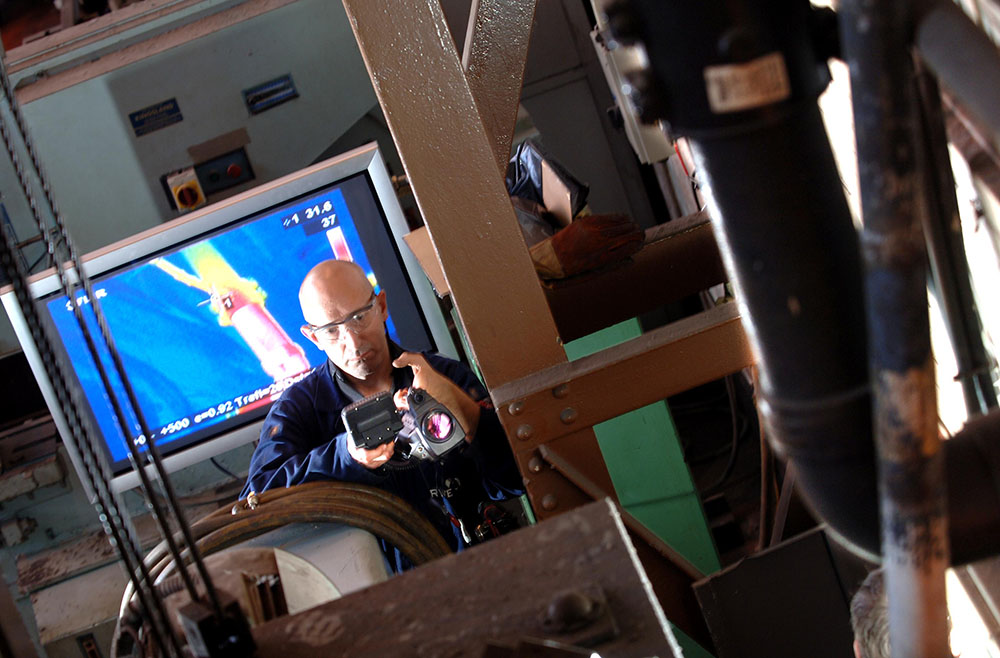
- Technological development and innovation in the engineering sector; Industry 4.0; and IT networking, new materials and artificial intelligence (AI)
- Inspection, test or monitoring procedures applicable to the
non-destructive technology: what they are and how to prepare and utilise them - Techniques and processes for maintenance and storage of tools, materials and equipment
- Techniques and processes for selecting, configuring, operating and using tools and equipment
- National and international standards applicable to the test or monitoring method: ISO 17359, EN 4179, BS EN ISO 16810 or BS EN 15495:2007
- Non-destructive technologies: methods and techniques
- Principles of collecting and analysing information and reporting on the application of NDT methods and techniques on equipment, parts, assemblies and subassemblies
- Materials science: material types, manufacturing processes, in-service conditions, defect types, defect mechanisms and growth rates
- Component, equipment and material failure: consequences and risks to life and the environment
- Types, uses and limitations of non-destructive technology tests, for analysis and measurements
- Continuous improvement principles and techniques
- Team-working principles
- Supervisory techniques and principles: leading and motivating, performance evaluation, mentoring, delegating and solving routine daily problems
- Equality Act; equity, diversity and inclusion in the workplace; and unconscious bias
- Verbal communication techniques: matching style to audience; barriers in communication and how to overcome them; and NDT engineering terminology
- Written communication techniques, including report writing, data collection and presentation and image acquisition
- Digital and information technology: management information systems (MISs), spreadsheets, presentation, word processing, email, virtual communication and learning platforms; awareness of General Data Protection Regulation (GDPR); and cyber security
- Workplace training and development activities: continuing professional development (CPD).
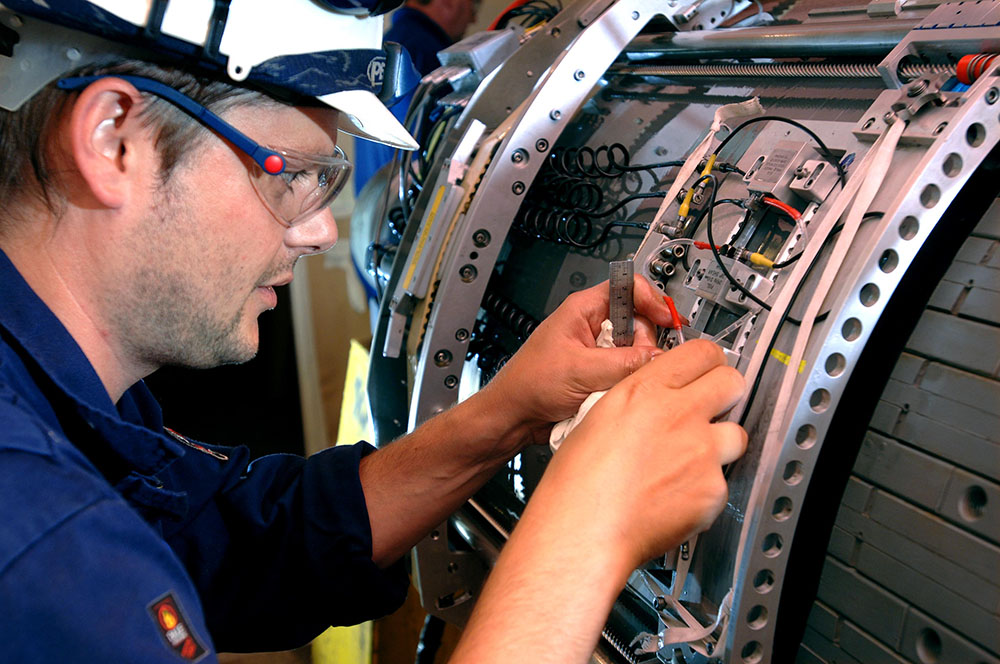
3.2 Skills – The ability to:
- Identify, organise and use resources to complete inspections, tests or monitoring on materials, products, plant or machinery for the
non-destructive technology - Plan, prepare for and apply inspections, tests or monitoring on materials, products, plant or machinery using non-destructive technology
- Use project management techniques throughout project phases, for example project justification, planning, analysis, execution and conclusions
- Implement quality control procedures
- Comply with health & safety regulations and procedures; apply safe systems of work
- Identify and document risks and hazards in the workplace; advise on and apply control measures
- Comply with environmental and sustainability regulations and procedures; segregate resources for reuse, recycling and disposal of waste; use resources efficiently; and apply sustainability principles
- Read and interpret engineering drawings, for example weld or component configuration
- Identify and report on the progress of work and issues or concerns with the non-destructive technology method
- Apply maintenance practices/techniques for tools, materials and equipment, for example clean, lubricate and replace parts
- Select, configure, use and operate tools and equipment
- Apply and review inspection and monitoring procedures
- Perform NDT methods in line with national and international standards applicable to the test or monitoring method, for example ISO 17359, EN 4179 and BS EN ISO 16810
- Apply NDT methods and techniques, such as vibration analysis, ultrasonics, radiography, thermography and eddy current
- Identify problems and apply analytical tools to identify causes and solutions, for example root cause analysis; review the effectiveness of methods deployed, actions and results
- Collect and interpret technical or analytical information or datasets from performed tests
- Apply team-working principles, including providing information, guidance or training to colleagues or stakeholders
- Apply equity, diversity and inclusion procedures
- Write technical reports
- Communicate verbally with colleagues and stakeholders
- Use information technology, for example for document creation, communication and information management; comply with GDPR and cyber security
- Carry out and record learning and development activities.
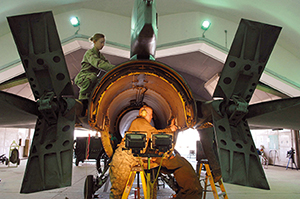
3.3 Behaviours:
- Prioritise and promote health & safety
- Take responsibility for work
- Adapt to changing work demands
- Collaborate within teams across disciplines and external stakeholders, supporting social inclusion in the workplace
- Be committed to CPD.
Individual employers will set their own criteria; however, it is advisable for apprentices to have a minimum of three GCSEs (or equivalent) at grade C or above (grade 4 or above in the new grading system), including English and maths. It is a mandatory requirement that apprentices aged between 16-18 without Level 2 English and maths will need to achieve this level prior to taking the end-point assessment; apprentices who began their apprenticeship training when aged 19+ will no longer be subject to the mandatory requirement. There is also a requirement to have good aided or unaided eyesight, to satisfy the mandatory NDT eyesight test, and to have appropriate physical fitness in order to operate in industrial environments.
5. Duration
The duration of this apprenticeship is typically 24 months.
6. Qualifications/NDT Certification
English and maths qualifications must be completed in line with the apprenticeship funding rules, which can be found at: https://shorturl.at/NBXsz Full details regarding the mandatory qualifications can be found at: www.instituteforapprenticeships.org/apprenticeship-standards/st0288-v1-1
7. Apprenticeship Level
This is a Level 3 apprenticeship.
 8. Professional Recognition
8. Professional RecognitionBINDT is licensed by the Engineering Council for registration for Engineering Technician (EngTech).
9. Review of Standard
This apprenticeship will be reviewed in accordance with the change request policy.
For further information contact:
The British Institute of Non-Destructive Testing, Midsummer House, Riverside Way, Bedford Road, Northampton NN1 5NX, UK.
Tel: +44 (0)1604 438300; Email: apprenticeships@bindt.org